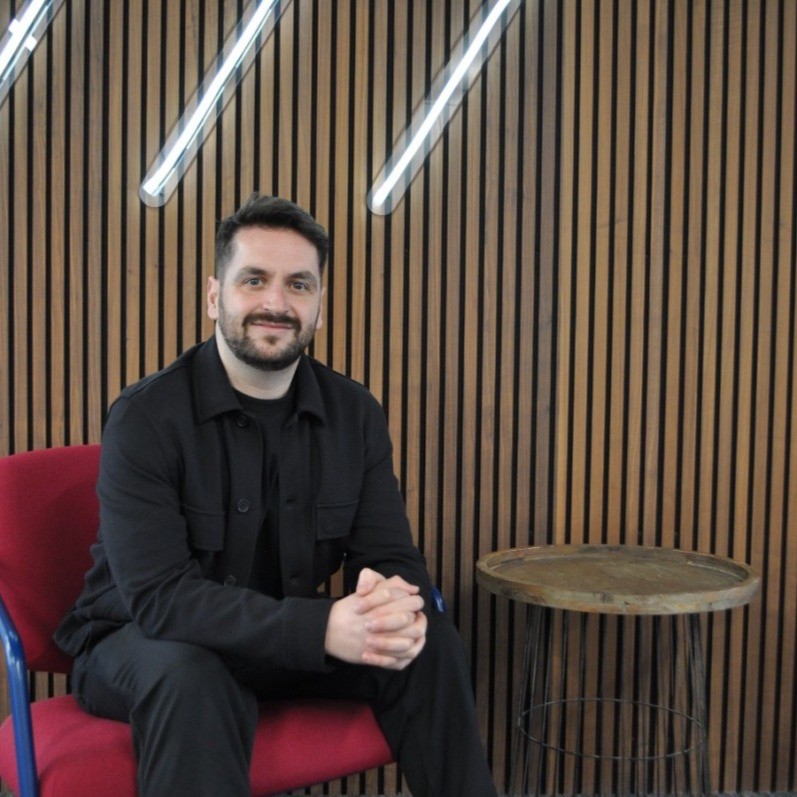Written by Sean Hanly

Date Posted: Monday, 21st July 2025
Mota is a technology leader with experience as both a tech lead inside major sports organisations like FIVB and Volleyball World and now as part of N3XT Sports, supporting clients through digital transformation. With a background in both marketing and computer science, he brings a user-centric approach to technology implementation in the sports industry.
"Technology is not the solution. It's the enabler." This philosophy has guided Mota throughout his career as he's helped major sports organisations navigate digital transformation. With experience as both a tech leader inside federations like FIVB and Volleyball World and now as part of N3XT Sports supporting clients through change, Mota brings a pragmatic perspective to an industry investing billions in technology.
His journey is particularly interesting because he didn't start in tech at all. Beginning with a marketing degree before pivoting to computer science, he brings a rare blend of user-centric thinking and technical expertise that puts people, not platforms, at the centre of digital evolution.
In this conversation, Mota shares insights on successful technology integration, the challenges of adoption, and how AI is reshaping sports from analytics to content production.
I'll give you two examples from different perspectives. First, from my time inside sports organisations, and then what we've seen working with clients at N3XT Sports.
When I was head of digital at Volleyball World, one of the most fundamental technology integrations we implemented was a data pipeline, essentially a CRM and CDP (Customer Data Platform) underneath their ecosystem. Volleyball at the time had several different touchpoints for fans: social media, their OTT channel (Volleyball TV), website, and mobile application. But we needed a layer underneath to understand fan behaviour and provide additional value for people signing up or paying for the OTT service.
We developed a retention model using a platform called Segment as the CDP, integrated with Oracle Marketing Cloud to push notifications, emails, and so on. The results were significant: we saw an uplift in subscriptions because we could create custom audience segmentations and target returning users more effectively. For example, if we knew someone liked a specific player like Gabi from Brazil, we could push content about that player to that person based on their preferences.
This created more value for fans, more value for sponsors, and better retention across the ecosystem with cross-selling opportunities. It was a fundamental shift because federations don't typically have a direct-to-consumer approach, but with the innovation mandate that FIVB had at the time, they wanted to go direct-to-consumer, and this technology helped them make that transition.
On the client side at N3XT Sports, we work on data solutions and support digital transformation journeys. A recent example is our work with the Professional Footballers' Association (PFA). We transformed their entire ecosystem, migrated them to the cloud, and built a member-centric approach.
The PFA provides services to their members, from Mohamed Salah to junior professional players under 18, and we developed a portal where players can request services. Before this, processes would take weeks because everything was manual: scanning contracts, sending emails, waiting for processing. Now, using Azure Cloud and Microsoft Dynamics, everything is completed within minutes.
The latest development is that with all their data centralised and digitalised, they're leveraging AI through Co-pilot to identify trends and segment their membership, understanding how to better service different clusters of members with e-learning, legal support, or medical assistance.
TRIA: Was there resistance to change with these new processes, or was there a big education piece needed?
There's something I always try to tell both our team and clients: technology is not the solution or your final output, it's your enabler. There are two fundamental things you need to do when embarking on such a transformation.
First, you need to look at yourself and do a proper assessment of how you're currently doing things. Understand your services, the entire design, and the journeys you want to build, whether from a fan perspective, member perspective, national federation perspective, or club perspective. In sports, you have many stakeholders, each with different needs requiring proper assessment. This allows you to develop something fit for purpose.
Then, based on that assessment, you select the technology that's right for you and fits your requirements.
What we've seen in the past, especially with COVID accelerating digital adoption, is that technology was often onboarded but not properly adopted. Solutions were implemented quickly without the right thinking behind them, forcing users to adapt to the technology rather than the technology adapting to them.
This is a major challenge that many sports organisations face. We support them with starter kits, change management, and adoption processes because, at the end of the day, there's a statistic that $7 billion a year is spent on sports tech. If you're spending that much money, you expect everyone to be using it!
TRIA: That's why user-centric design is so important, if people can't use it, they won't adopt it.
Exactly. And a year later, people see no return from their investment, and there's no longevity to what they're trying to adopt.
The challenges we typically face are twofold: technical challenges and adoption challenges.
On the technical side, we often encounter organisations with legacy systems that have been in place for 20 years. Everyone's been using them, but they reach a point where their shelf life is over, and even the provider no longer supports maintaining them. Transforming these systems requires thinking about whether to buy a new solution or build from scratch.
It takes considerable understanding of how the existing system is integrated, what its data structure is, what governance surrounds it, and how it connects with other systems. It's not simply replacing one thing with another, it's redesigning the entire approach. We tackle this by evaluating the solution thoroughly and examining the service design.
The second challenge is adoption. When a legacy system has been in place for 20 years, both external and internal people's behaviours have adapted to it. They're comfortable working with it daily. Shifting to a new system might face rejection, wasting your investment if people don't use it.
It's crucial to provide training, communicate early about the coming change, and involve people in the transformation journey, seeking their input. They need to take ownership of the new platform, whether it's a website, CMS, information system, or CRM, to ensure they'll actually use it.
We see this quite starkly with AI projects. Implementing an AI solution isn't simply about giving people access to Co-pilot, ChatGPT Pro, or Claude. There needs to be training, sensitivity, and education around how to use it, even how to write an effective prompt to get the most value from these tools.
At N3XT, we're quite diverse. About 60% of our employees are ex-athletes, and we have around 16 different nationalities, so adaptation is the name of the game. We have clients in the GCC (Gulf Cooperation Council) region like Saudi Arabia and Qatar, as well as clients in Europe and Asia, so we need to adapt not just to scale but to culture and ways of working.
The sequence for change management is always the same: communication, training, engagement, and support. These are the four steps we follow. Where we adapt is in the execution details.
For organisations with multiple offices around the world and multiple languages, we adjust our communication and training to accommodate different languages and time zones. We also adapt our support approach accordingly.
What remains constant is maintaining a regular cadence of communication, newsletters or emails informing people about upcoming changes, invitations to demo sessions so they can see what's coming, and UAT (User Acceptance Testing) phases where they can interact with the new platform and provide feedback.
For training, we always cap sessions at 12-15 people maximum, regardless of the organisation's size. If it's a large company, we'll run multiple sessions over several weeks. We've found that putting 50 people in one room prevents meaningful engagement, people don't ask questions or participate fully. Smaller groups allow for exercises and scenario-based learning where teams can practice completing forms, testing processes, and providing feedback.
TRIA: That sounds like a very in-depth, thoughtful approach.
The warning I'd give is that it will always catch up to you, that's the reality. If you skip steps, it will eventually cause problems.
Since COVID, we've seen more investment in direct-to-consumer approaches from sports organisations. They recognise the value in technology-based business models that generate value for sponsors, ticket holders, and streaming services. Technology is becoming more deeply ingrained in every department and every organisation.
You can't just develop something in isolation, deploy it, and expect everyone to use it. If you try to cut corners on adoption or fail to think through how the technology will integrate into daily operations, you'll inevitably need a second project after deployment to make it fit. There's no avoiding it.
This creates a vicious cycle: management becomes unhappy because people aren't adopting the technology despite the significant investment, and the problem compounds itself.
We're seeing this with AI now. At the end of 2023 when ChatGPT became widely available, everyone jumped on it. Now organisations are asking more thoughtful questions: How will this integrate into our systems? How can we leverage AI to improve customer service, IT governance, or daily operations?
I think 2025 will bring a real shift in how sports organisations and other businesses integrate AI into their everyday work, especially as agents become more widely available.
AI has been used in sports for quite some time, it's not new. We've seen it primarily in analytics, content production, and certain data processes.
In analytics, it's used to analyse videos of athletes, tracking performance metrics like running speed, and providing visual identification that adds statistics to broadcast systems. Companies like Second Spectrum have been doing this with the NBA.
For content production, companies like WSC use AI to detect highlights and key moments in games, cutting clips and publishing them across social media channels.
In data processing, we've seen AI in customer service, when you're having issues with your OTT subscription, you might interact with a chatbot using some level of artificial intelligence to process your request.
But since OpenAI launched ChatGPT, we've seen the rise of large language models being applied in new ways: from writing emails faster to processing requests or searching databases using natural language instead of writing Python queries.
The future I see is that virtually all products will integrate some element of AI. Salesforce now has Einstein, allowing users to ask questions and prepare content just like in ChatGPT. Photoshop has integrated AI image completion. We've seen it in Figma and multiple other solutions.
Beyond these applications, we're moving toward AI that doesn't just provide output but actually makes decisions. I think 2025 and 2026 will be the years of AI agents, where we'll see more optimisation and reliance on AI to make decisions or perform tasks, enabling people to focus on strategic work.
TRIA: It's mind-blowing to think about where this might lead, will we even need mobile phones if AI is integrated everywhere?
Exactly!
It's funny because my first degree was in marketing, I didn't start in tech, I ended up there. After getting my bachelor's in marketing, I went back to school for computer science and then got my master's.
I wouldn't necessarily advise starting in tech from the beginning, because I don't regret my marketing background at all. It helps me daily to think about users and consumers, essentially what marketing is about: adapting to the consumer.
If there's one thing I would tell my younger self, it would be to be even more data-driven. Now with AI and everything we do in technology, everything revolves around data. Whether it's first-party data, consumer data, or third-party data. You need to understand how to evaluate it, integrate it, and measure it well.
So that's my advice: be more analytical and more data-driven. That's the foundation for success in today's technology landscape.
Mota's journey shows how successful technology adoption requires putting people first, whether they're fans, athletes, or staff. His blend of marketing insight and technical expertise offers a refreshing perspective on digital transformation in sports.
If reading this sparked ideas from your own tech adventures, we'd love to hear them. Every professional has unique stories that could light the way for others navigating today's fast-changing digital landscape.

Sean has more than ten years’ experience guiding digital strategy across marketing, sales, people and operations. He works closely with teams and partners to keep go-to-market plans on track and results measurable.
Connect on LinkedIn
Written by Sean Hanly

Written by Rob Carswell

